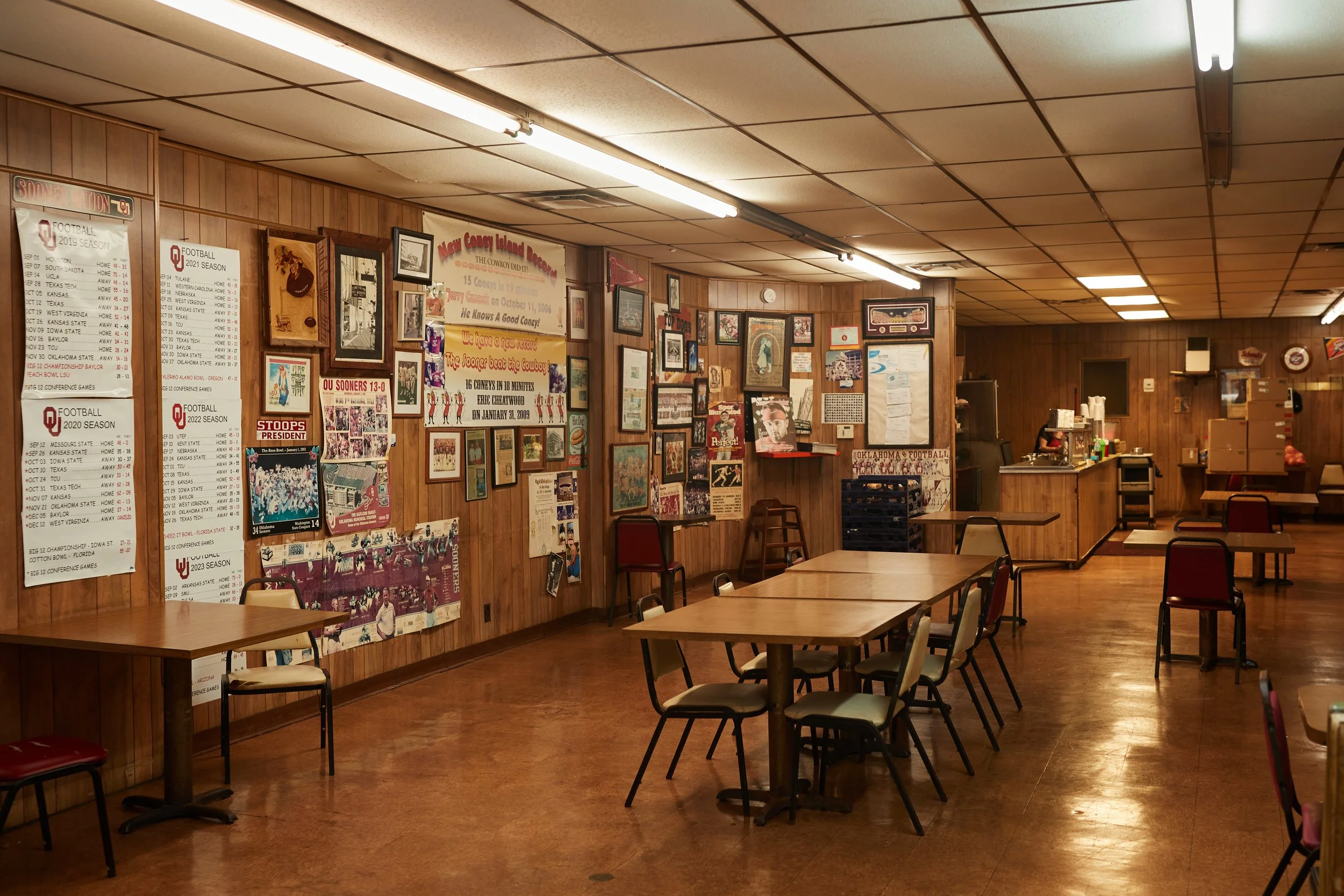Coney Island
Words by Anna Kinder / Photos by Charlie Neuenschwander
In a world where you have to choose from 12 kinds of artisanal aioli just to order lunch, Coney Island is an oasis of simplicity, with a straightforward menu and a price point most can afford. Two bucks gets you a coney loaded with mustard, chili, and onions. The Frito chili pies start at $3.50. And for the big spenders, there’s the Greek-style spaghetti topped with chili, cheese, and onions for $6. Perhaps its accessibility is what makes it a microcosm of OKC—one of many parallels with its namesake of Coney Island, New York.
“When people come to this country and see the Statue of Liberty, I think there should be a sign that says ‘Come with me to Coney Island first,’” the photographer Harold Feinstein once said of his stomping grounds. “Because whatever New York is to the United States, Coney Island is to New York. It’s a multitude of all colors and every language under the sun.” He also described it as a “working-class paradise,” an epithet equally apt for the landlocked Coney Island located at 428 W. Main St. in downtown OKC.
The establishment has a carnival-esque vibe beyond its name and style of cuisine. A group of teenage boys saunters up to the counter to place a coney order, comparatively small for this bunch, judging by the ensuing heckling. “Oh, ya had breakfast, huh?” teases Judy Allen, a part-time employee of five years. “All talk, no action—I see!” chimes in Merdina Orr, who’s worked there for the last 48 years.
The restaurant’s coney-eating competition is the stuff of legend. According to Merdina, the official record is 17 coneys in 17 minutes. A couple of large banners remain up, recognizing champions of yesteryear and vestiges of the glory days. Today, anyone who can throw down 10 coneys in 10 minutes earns a spot in the hall of fame. And why not go a little bit overboard when the chili cheese coneys are $2.25 a pop?
Alongside the banners, eight decades of OU football win-loss records adorn the 1960s wood paneling like rings on a tree hinting at its age. But in reality, Coney Island is even older than that. Depending on whether you believe the sign out front or the 2015 article in The Oklahoman, it’s been open since 1924 or 1928. Either way, it’s been around for about a century, so it must be doing something right.
Bill Mihas has owned the joint since 1966 after purchasing it from its founders, James and Mike Soter, but Bill stopped coming in during the pandemic, leaving Merdina to hold down the fort. It’s obvious from the way she balances multiple coneys on each arm while catching up with her regulars, she’s more than capable. “It always surprises me how many orders she can remember,” Judy remarks. And there are lots of regulars, from all walks of life.
Although Coney Island’s clientele is as diverse as it gets, everyone seems to get along—a remarkable feat in this polarizing age—but after getting to know Merdina better, it makes sense. “You wouldn’t believe all the different types of people that come in here, but I treat ‘em all the same. Until they piss me off,” she tells me. “But even then, aren’t you still kinda treating them the same?” I retort playfully. She chuckles before returning to her closing duties.
When I ask how she landed at Coney Island in the first place, Merdina flashes a mischievous glance at Judy before responding, “Oh, a friend of a friend.” I can tell there’s a story there juicier than a hot wiener, but I know better than to pry. What I can tell you is Merdina was 17 years old when she started working at the Capitol Hill location (which is now under different ownership), and the fact that she stuck around speaks volumes—especially about Bill. “He may seem like an old grump now, but he’s a nice guy. He’s always been a nice guy,” she remarks with a palpable fondness in her voice.
My friend Yoko Raney shares Merdina’s admiration, describing Bill in a separate conversation as “a little grumpy, but also encouraging.” As a little girl, she spent many an afternoon at Coney Island with her brother while their father worked at the IRS building nearby—and although her brother was 10 years her senior, Yoko could dominate him in chess, which Bill found amusing.
“I have this distinct memory of him in a dirty apron with his hands on his hips, scowling at our game. When we’d argue over the rules, he was the person we’d ask—because, in our minds, he knew everything,” she reminisces. They stopped playing chess there after the Murrah bombing, which Merdina remembers like it was yesterday. “When I walked back here from the payphone, that whole window caved in,” she recounts, shaking her head.
After all this time, Merdina doesn’t seem burned out. In fact, she seems to genuinely enjoy what she does. Laughter is a constant at Coney Island, and after spending several hours there, I can confirm Merdina truly does treat everyone the same—from lawyers and little kids to bikers and food writers. It’s simple. You hold up your end of the bargain by bringing cash and not being a jerk, and Merdina Orr will hold up hers: fast, friendly service and coneys that hit the spot but don’t cost much.
“This place don’t look like much of anything, but the food is good,” she mutters at one point, but in my humble opinion, therein lies all of Coney Island’s charm. Life is too much. The world is too much. Coney Island, on the other hand, is just right.




